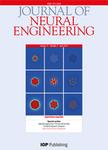版权所有:内蒙古大学图书馆 技术提供:维普资讯• 智图
内蒙古自治区呼和浩特市赛罕区大学西街235号 邮编: 010021

作者机构:Tsinghua Univ Dept Biomed Engn Beijing Peoples R China Chinese Acad Sci Inst Semicond State Key Lab Integrated Optoelect Beijing Peoples R China Univ Chinese Acad Sci Sch Future Technol Beijing Peoples R China Chinese Inst Brain Res Beijing Peoples R China
出 版 物:《JOURNAL OF NEURAL ENGINEERING》 (神经工程学杂志)
年 卷 期:2023年第20卷第4期
页 面:046018-046018页
核心收录:
学科分类:0831[工学-生物医学工程(可授工学、理学、医学学位)] 1002[医学-临床医学] 1001[医学-基础医学(可授医学、理学学位)] 10[医学]
基 金:National Key Ramp D Program of China [2022YFF1202303] National Natural Science Foundation of China [62201321, 62071447] Strategic Priority Research Program of Chinese Academy of Sciences [XDB32040200]
主 题:brain-computer interfaces steady-state visual evoked potentials spatial coding sub-region combination
摘 要:Objective. In studying the spatial coding mechanism of visual evoked potentials, it is significant to construct a model that shows the relationship between steady-state visual evoked potential (SSVEP) responses to the local and global visual field stimulation. In order to investigate whether SSVEPs produced by sub-region stimulation can predict that produced by joint region stimulation, a sub-region combination scheme for spatial coding in a high-frequency SSVEP-based brain-computer interface (BCI) is developed innovatively. Approach. An annular visual field is divided equally into eight sub-regions. The 60 Hz visual stimuli in different sub-regions and joint regions are presented separately to participants. The SSVEP produced by the sub-region stimulation is superimposed to simulate the SSVEP produced by the joint region stimulation with different spatial combinations. A four-class spatially-coded BCI paradigm is used to evaluate the simulated classification performance, and the performance ranking of all simulated SSVEPs is obtained. Six representative stimulus patterns from two performance levels and three stimulus areas are applied to the online BCI system for each participant. Main results. The experimental result shows that the proposed scheme can implement a spatially-coded visual BCI system and realize satisfactory performance with imperceptible flicker. Offline analysis indicates that the classification accuracy and information transfer rate (ITR) are 89.69 & PLUSMN;8.75% and 24.35 & PLUSMN;7.09 bits min(-1) with 3 s data length under the 3/8 stimulus area. The online BCI system reaches an average classification accuracy of 87.50 & PLUSMN;9.13% with 3 s data length, resulting in an ITR of 22.48 & PLUSMN;6.71 bits min(-1) under the 3/8 stimulus area. Significance. This study proves the feasibility of using the sub-region s response to predict the joint region s response. It has the potential to extend to other frequency bands and lays a foundation for future